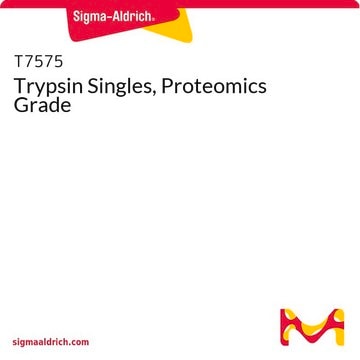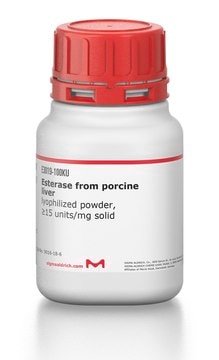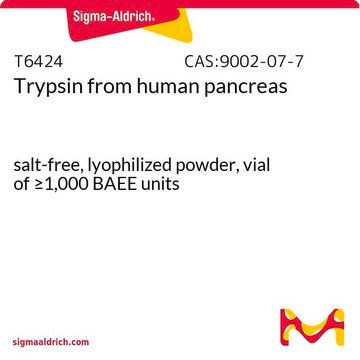This product is soluble in 1mM HCL.
T6567
Tripsina from porcine pancreas
Proteomics Grade, BioReagent, Dimethylated
Sinónimos:
Porcine Trypsin, Trypsin for Mass Spectropetry
Seleccione un Tamaño
$65.20
Seleccione un Tamaño
About This Item
$65.20
Productos recomendados
biological source
Porcine pancreas
Quality Level
product line
BioReagent
solubility
1 mM HCl: soluble 1 mg/mL, clear, colorless
shipped in
wet ice
storage temp.
2-8°C
General description
Application
- Digestión proteica en gel y análisis mediante espectrometría de masas con MALDI-TOF[3]
- Análisis mediante espectrometría de masas de ionización por electrospray (ESI-MS)[4]
- Perfilado del proteoma de superficie de L. plantarum[5]
- Filtración en gel, ultracentrifugación y microscopia electrónica de sombras rotatorias[6]
- Espectrometría de masas[7][8]
Biochem/physiol Actions
related product
signalword
Danger
hcodes
Hazard Classifications
Eye Irrit. 2 - Resp. Sens. 1 - Skin Irrit. 2 - STOT SE 3
target_organs
Respiratory system
Storage Class
11 - Combustible Solids
wgk_germany
WGK 1
ppe
dust mask type N95 (US), Eyeshields, Faceshields, Gloves
Certificados de análisis (COA)
Busque Certificados de análisis (COA) introduciendo el número de lote del producto. Los números de lote se encuentran en la etiqueta del producto después de las palabras «Lot» o «Batch»
¿Ya tiene este producto?
Encuentre la documentación para los productos que ha comprado recientemente en la Biblioteca de documentos.
Los clientes también vieron
Artículos
Evaluation of Recombinant, Chemically Treated Trypsin in Proteomics and Protein Characterization Assays
Get better detection and quantification of proteases with this high-sensitivity red protease detection assay.
Pretreatment with Mucinase StcE increases glycopeptide identification from mucin samples, enhancing sample preparation efficiency for glycopeptide analysis.
The field of proteomics is continually looking for new ways to investigate protein dynamics within complex biological samples. Recently, many researchers have begun to use RNA interference (RNAi) as a method of manipulating protein levels within their samples, but the ability to accurately determine these protein amounts remains a challenge. Fortunately, over the past decade, the field of proteomics has witnessed significant advances in the area of mass spectrometry. These advances, both in instrumentation and methodology, are providing researchers with sensitive assays for both identification and quantification of proteins within complex samples. This discussion will highlight some of these methodologies, namely the use of Multiple Reaction Monitoring (MRM) and Protein-AQUA.
Protocolos
Continuous spectrophotometric rate determination method using BAEE substrate measures trypsin activity, essential for enzyme characterization.
-
What can I use to solubilize this Product T6567, Trypsin from porcine pancreas?
1 answer-
Helpful?
-
-
How can we digest protein using Product T6567, Trypsin from porcine pancreas?
1 answer-
As per Sigma R and D the information is as follows: In order to efficiently digest a protein with trypsin, it must be denatured and the disulfide bonds modified by reduction and alkylation, or at least reduced. Many intact proteins are highly resistant to digestion with trypsin. If you do not want to reduce and alkylate, you can then just boil the protein with 5 mM DTT or 20 mM 2ME for 10 minutes, and then quickly cool on ice to denature the protein. This may result in a precipitate, but the trypsin will still digest the protein and it will clear within an hour or two. You can also dissolve the protein in 6 M guanidine-HCl or 8 M urea. Reduce and alkylate using the PROT-RA kit or other suitable method. Then they would have to dilute the solution to less than 2 M of either denaturant and then add the trypsin. This is the method that we use routinely in the lab.
Helpful?
-
-
What is the Department of Transportation shipping information for this product?
1 answer-
Transportation information can be found in Section 14 of the product's (M)SDS.To access the shipping information for this material, use the link on the product detail page for the product.
Helpful?
-
-
Is Product T6567, Trypsin from porcine pancreas, TPCK treated?
1 answer-
The product has been treated with TPCK to remove chymotryptic activity, further purified through affinity chromatography, and lyophilized, resulting in convenient use and highly specific cleavage. This information is on the product page under application.
Helpful?
-
-
What is the package size of Product T6567, Trypsin from porcine pancreas?
1 answer-
Each vial content 20 ug of the product.
Helpful?
-
-
How can we get Trypsin sequence information for Product T6567, Trypsin from porcine pancreas?
1 answer-
If you are looking for trypsin sequence information, you have to go to the NCBI Protein Data Bank.
Helpful?
-
Active Filters
Nuestro equipo de científicos tiene experiencia en todas las áreas de investigación: Ciencias de la vida, Ciencia de los materiales, Síntesis química, Cromatografía, Analítica y muchas otras.
Póngase en contacto con el Servicio técnico












